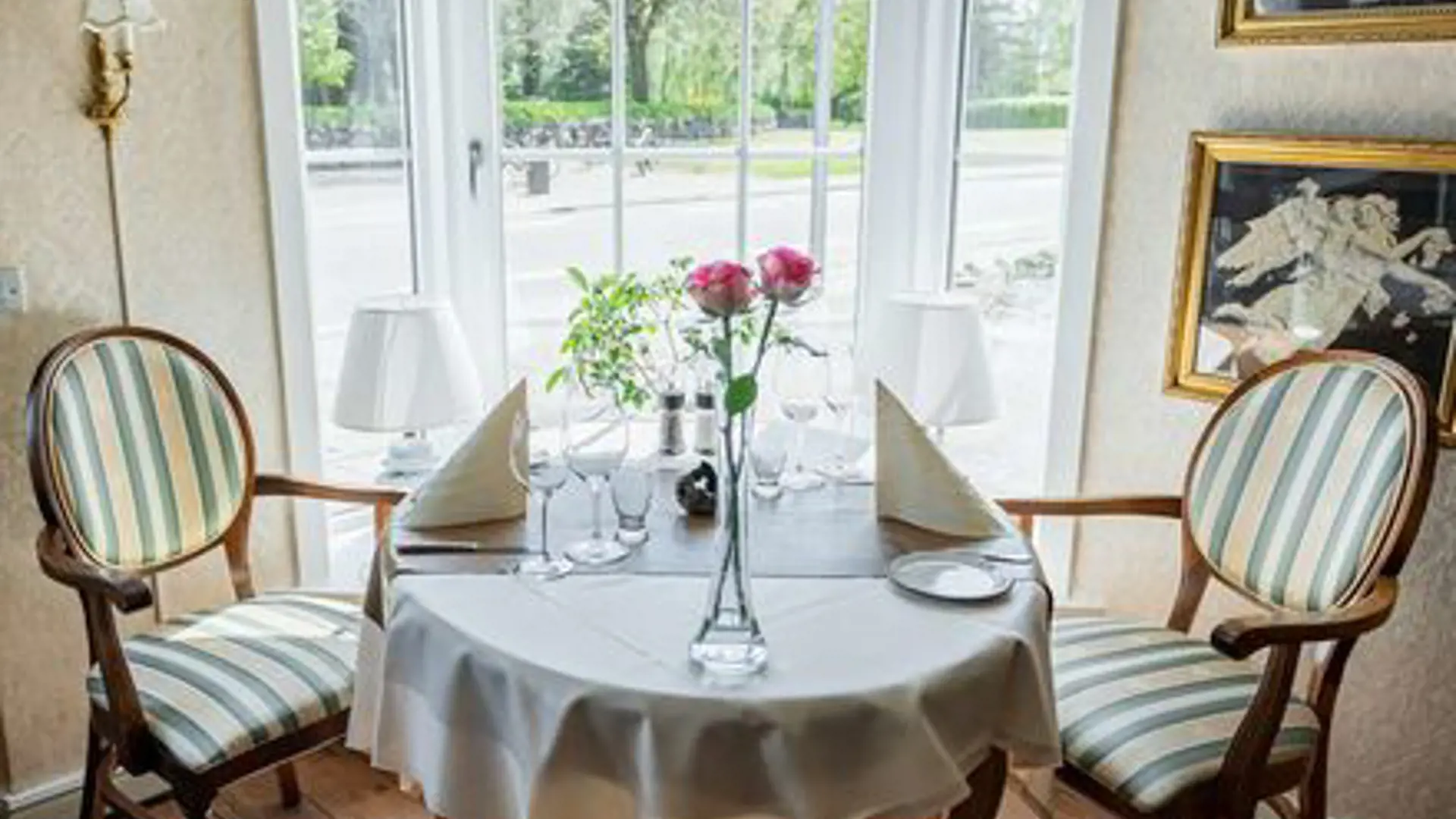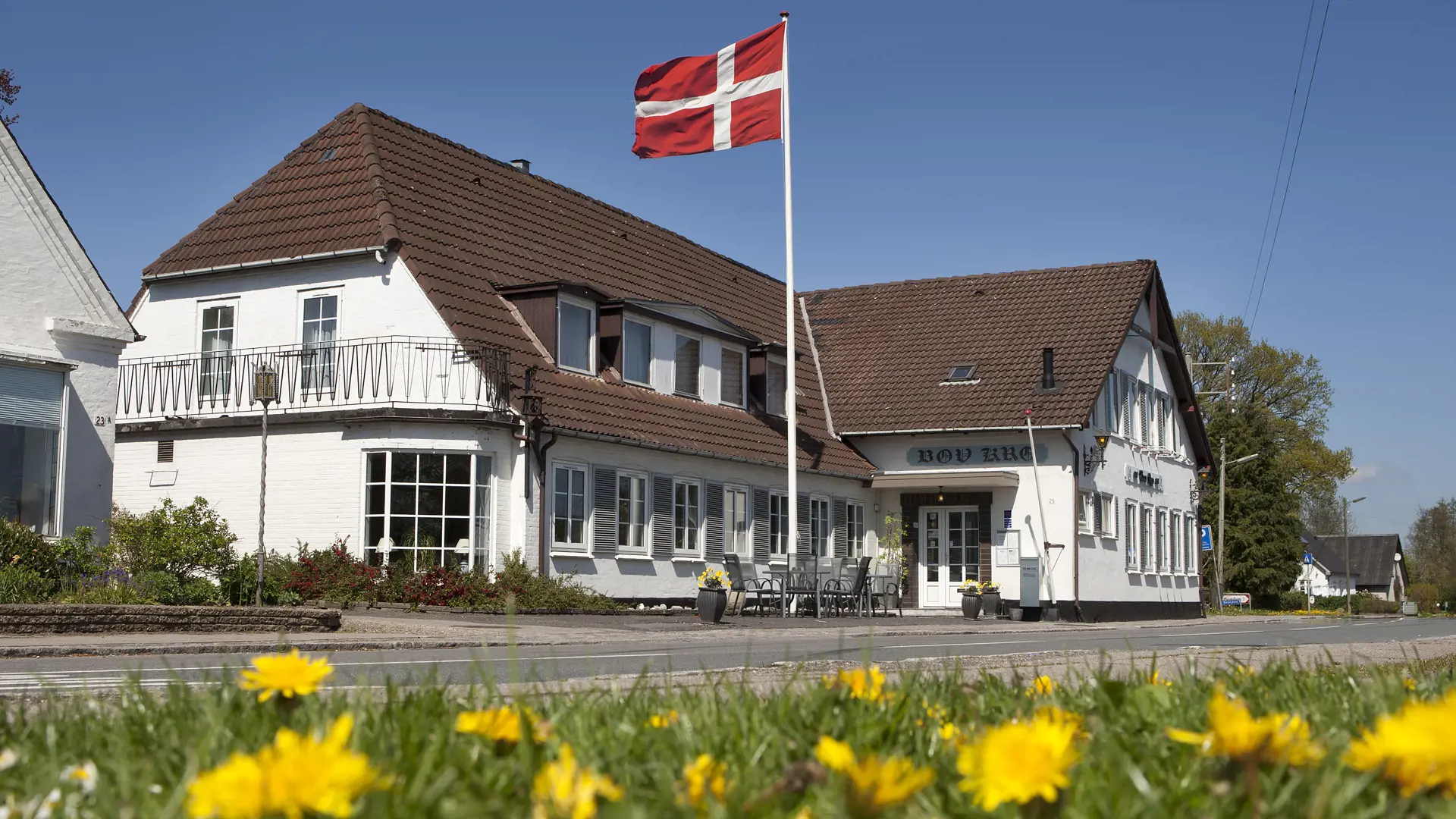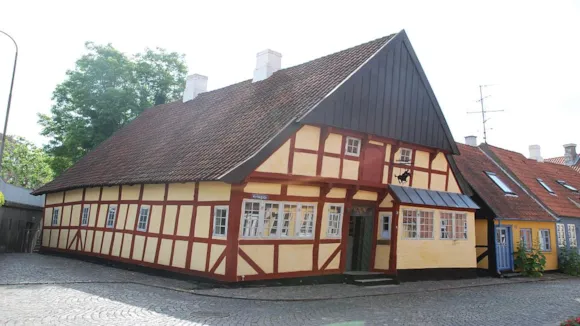Includes per person per night:
- 3-course dinner (chef's choice)
- Overnight accommodation
- Breakfast
4.68160375249836 of 5 Stars

Includes per person per night:
Click the "See calendar and prices" button to choose dates and see the room selection.
See calendar and prices: Stay With Half BoardHærvejen 25, 6330 Padborg
Show map

Includes per person per stay:

3 days/ 2 nights
Includes per person per stay:

Minimum stay 3 days / 2 nights
Includes per person per night:

Includes per person per night:

Minimum 3 days / 2 nights
Includes per person per night:

Includes per person per night:

Min. 3 days/ 2 nights
Includes per person per night:

0.35 km
The Lyreskoven forest is located along the two roads Tøndervej and Omfartsvejen. Parking is possible coming from Tøndervej and there are also entrances coming from Smedeby, Omfartsvejen and Hærvejen. Take the dog for a walk, since part of the yellow route is in fact a designated dog forest. Both the Blue and Yellow route is suitable for the walking and the jogging type.
What you will find on your way along Lyreskovstien
On the route, you will find two fire places to be used freely and a hill commonly used for sledding during the winter or for exercise during the summer. There are also two lakes with shallow waters, which gives a clear view to study animal life in the water. In the forest Byskoven, there is a one-person bunker from the Second World War. The Historical Hærvejen makes its way through the area and is a part of Lyreskovstien.
Project Purpose of Lyreskovstien
The project aims to create an outdoor exercise and recreation area for all residents in the vicinity as well as Families with children, young people, elderly people, students and teachers from The Lyreskov School, Hærvej hikers and tourists. Tables, benches and exercise equipment will be built in natural materials along the Lyreskov Path.
Lyreskovstien as a route for excercising
The goal of Lyreskovstien as a route for exercising is to offer an outdoor gym as an alternative to the traditional gym experience. The tools must besides being fun to use, also be challenging and provide an opportunity to exercise everything from muscles to balance, rotation, coordination, agility, flexibility and endurance.
In The Lyreskov School, an outdoor exercise area with metal fitness equipment will be built to be freely available and will provide the opportunity to exercise at any time of the day without a gym membership.
Lyreskovstien as an excursion spot
Lyreskovstien should be a place with nice excursions for families with children, joggers, dog walkers and everyone who loves the natural environment’s beautiful scenery.

2.44 km
The self-governing institution "Hjemmeværnsmuseet" was established in 1988 in the historic Frøslev Camp and is a nationwide cultural-historical museum that houses the historical exhibition of the Home Guard.
The main idea behind the historical exhibition of the Home Guard is to describe the development of the Home Guard in relation to events in the surrounding world.
The exhibition is divided into four eras as follows: the first era is the 1940s with the establishment of the Home Guard, the second era is the 1950s with prosperity and progress, the third era covers the 1960s, 1970s, and 1980s with the Cold War, and the fourth era encompasses the 1990s and the future.
Spatially, the exhibition is divided accordingly, and in a small separate room called a "time machine," visitors will be introduced to the respective period through a description of characteristic and typical events and objects, including audio-visual means.
Since 1989, the Brigade Collection has been housed in the Hjemmeværnsmuseet and is an exhibition about the Danish Brigade DANFORCE, which was established and trained in Sweden from 1943 to 1945. The brigade, which reached about 5,000 volunteers, including 300 women, consisted mainly of Danish military personnel who were ordered or fled to Sweden, as well as resistance fighters and Jews who had to escape from Denmark. The brigade returned to Denmark on May 5, 1945, and subsequently carried out a wide range of guard duties, including at the Danish-German border.
Ongoing special exhibitions are held, shedding light on different periods or aspects of the Home Guard's existence. Lectures and guided tours of 1-2 hours can be arranged based on the nature of the visit. The content can be tailored to the participants' age, mobility, and developmental stage, covering Danish security and defense policy with an emphasis on the voluntary defense. The tour can be combined with visits to other military-historically significant attractions in Schleswig/Southern Jutland.

2.44 km
The Frøslev Camp Museum illustrates the history of the Frøslev Camp during World War II.
In 1944-45 the Frøslev Camp housed the prisoners of the German Security Police in Denmark, primarily members of the Resistance. The camp was built in order to avoid deportations of Danes to concentration camps in Germany, even so some 1.600 Frøslev prisoners of a total of 8.000 internees were deported to Germany.
The Museum, which is owned by the Danish National Museum, is situated in the main watchtower and two former prisoners` huts. The exhibition shows everyday life of the camp as well as the conditions in those concentration camps in Germany, where Frøslev prisoners were deported to. The Frøslev Camp is one of the most intact German camps in Europe, and is a Danish national monument.

2.71 km
2.76 km
The path was made after Southern Jutland was returned to Denmark in 1920 and the route was used by the border gendarms on patrol.

11.54 km
In 1580, Duke Hans the Younger inherited large landed properties and the former Ryd Abbey from his uncle Hans the Older, however he is in need of a befitting accommodation on this side of the inlet Flensborg Fjord.
Hans the Younger gets the rest of the abbey removed and during the years 1583 - 87, a summer castle is built on the site, reusing some of the precious building materials from the abbey.
October 9 1622 Duke Hans the Younger dies during a stay at Glücksburg Castle. Another death at the castle within a noble house is Frederik the Seventh, who passes in the age of 55 on November 15 1863 - a few month later the War 1864 brakes out.
The beautiful white castle is a 3 storeyed square building with a tower in each corner. The castle is surrounded by an artificial lake. The large halls have vaulted ceilings and the castle is fitted with some of the most modern facilities at the time - garderobes. The garderobes are small outside bays with a toilet, discarding in the moat - where they also kept their fish!
The castle chapel is situated in one of the wings and was only used by the ducal family and their court. Later the chapel was used as a city church and today it is possible to get married in the chapel by appointment with the museum at Glücksburg Castle.
For more information and history - visit the website of the castle museum.
Glücksburg Castle
Großestr. 1
24960 Glücksburg
Germany

17.35 km
The very first palace in Graasten was a hunting and leisure palace built in the midst of the 16th century. After it burned down in 1603, a new palace was built, probably where the current palace´s south wing is now.
Shortly before 1700 the Chancellor Frederik Ahlefeldt built an impressive Baroque palace, which itself unfortunately burned down in 1757, only leaving the palace church. The current Graasten Palace, or rather the south wing, thus originates from 1759. In 1842 the main building was added.
In 1935 the right of use of the palace was given to the late King Frederik IX and Queen Ingrid. Queen Ingrid was very interested in flowers and stood for the planning of the garden at Graasten Palace until her death in 2000. The interest in flowers and the garden was continued by her daughter H.R.H. Queen Margrethe II.
There is no public access to the buildings and rooms of the palace and as Graasten Palace Church is being renovated, it is also closed to the public until spring 2027.
During the New Year's speech in 2023, HM Queen Margrethe II announced her abdication and on 14 January 2024, Denmark got a new king and queen in the form of King Frederik X and Queen Mary.
When the royal family is in residence at Graasten Palace, the area is closed to the public and there is no access to Graasten Palace Gardens and Church; The Palace Church will not be open for services and summer evening singing due to renovations.
This was the first year we were able to receive the new royal couple, who travelled on foot from the official reception on the square to Graasten Palace. After the royal couple's departure from Graasten Palace, H.M. Queen Margrethe II stayed in the summer residence.
Graasten Palace Gardens will be closed from the morning of Monday 30 June 2025 and will not open until the late afternoon of Friday 15 August 2025. The August date is subject to change.
Guard replacement
Once the palace is inhabited, a royal split flag goes to the top of the pole on the palace's bell tower and the Royal Life Guard sets up to guard. Every day there is a shift change of the Royal Life Guard. The guard starts from Det Gule Palæ, Ahlefeldtvej 5, where the new guard’s line up. Accompagniet by two tambours they march at 11.43 a.m. through Gråsten via Borggade, Torvet and Slotsgade to the palace, where the shift will take place at the guard house at 12.00. When King Frederik the X is in recidence, the march on Fridays is accompanied by the Royal Life Guards Tambour Corps and the changing of the guard takes place in the palace courtyard.
Fridays concerts
Will be held in the palace courtyard in connection with the changing of the guard during the royal couple's stay at the palace.

22.92 km
Set sail at Cultural History Aabenraa. The museum reflects the proud maritime tradition that characterized Aabenraa in the age of sail, which later became an important element of the city's identity. Here you can experience one of the largest Danish collections of ship portraits, which used to hang in captains' homes.
Opening hours:
The museum reopens for the season on March 28, 2025.
Only from Thursday until Sunday.

26.08 km
Dybbøl Mill is one of Denmark's most important national symbols. During the war of 1864, it became the symbol of the bravery of the Danish soldiers on the battlefield, and in the period 1864-1920 the symbol of the struggle of the Danish-minded southern Jutlanders under German rule. At the same time, it was a completely ordinary mill, which was run until 1990.
Today, the mill is a museum. On the ground floor of the grain magazine, there is an exhibition about the history of the mill 1744-2020. Here you can learn more about the influence of the two Schleswig Wars on the mill and about the family who lived there at the time. On the magazine loft, you will find an exhibition about Dybbøl as a symbol and about the many national celebrations - both Danish and German - that have taken place at Dybbøl Banke.
In the mill tower, you can see the old grinders and the big spur wheel. Afterwards you can go out on to the gallery and enjoy the beautiful view of Dybbøl Banke, Sønderborg and Vemmingbund.
If you want to visit both Dybbøl Mill and the History Centre Dybbøl Banke, an online combi-ticket is available from 1 April to 31 October 2025, where you save DKK 11.00 for children aged 5-15 years and DKK 21.00 for guests from the age of 16.

27.65 km
The castle was founded before 1200 and was from 1550-70 rebuilt into a four wing Renaissance castle.
The museum tells about the history of North Slesvig from the Middle Ages to the present with the main focus on the wars of 1848-50, 1864, 1914-18, the plebiscite and the reunification of North Slesvig with Denmark in 1920.
Large culture-historical collections with furniture, textiles, crafts and art from North Slesvig.
Openinghours: See "The Museum on Sønderborg Castle"

28.03 km
Lean about the history og Tilting-the-Ring, see the president lances, the saddles and the reins, the beautiful trophies, the Lances of honour and the painting "Tilting Parade" by Fritz Carstensen.
Visit the Medal Corridor, the Protocol Room and the Document Room, where you can see different medals and ribbons and see who have won the titles of king, Crown Prince and Prince throughout the years.
The museum is open 2 days of the week from June to and incl. August as well as Friday, Saturday and Sunday in the weekend of the Tilting-at-the-Ring festival in Sønderborg City.
Groups all year after appointment with Hans Struck tel. +4574427575.

28.12 km
The memorial stone on Kirketorvet was sketched by the architect Thomas Havning (1891-1976) and erected in 1923.
There are 192 names, German as well as Danish, all fallen in 1. WW (1914-18). Notice the top of stone which is similar to a sarcophagus.
Each year at the time of conclusion of peace – the 11. November at 11 am – wreaths are placed at the memorial stone.